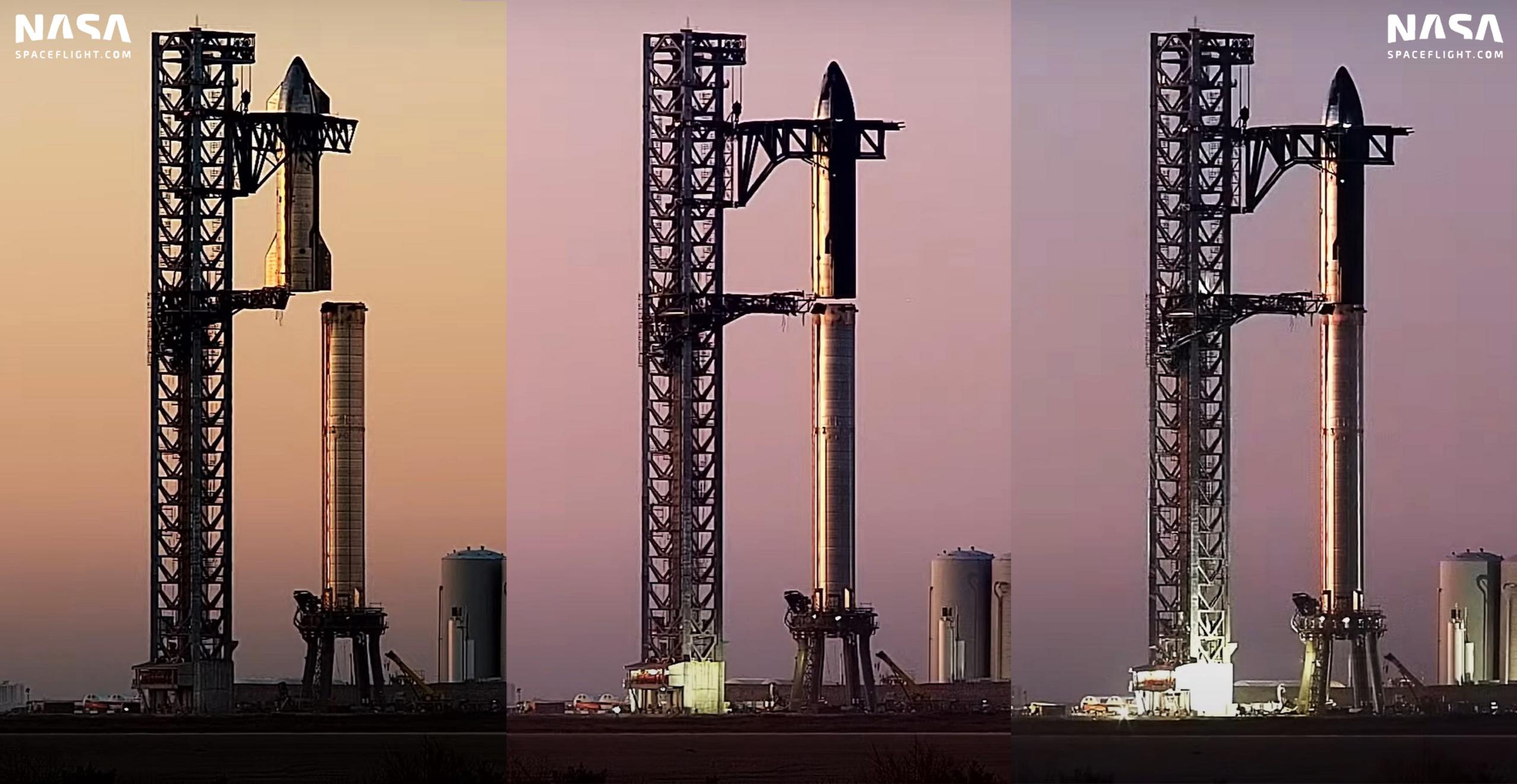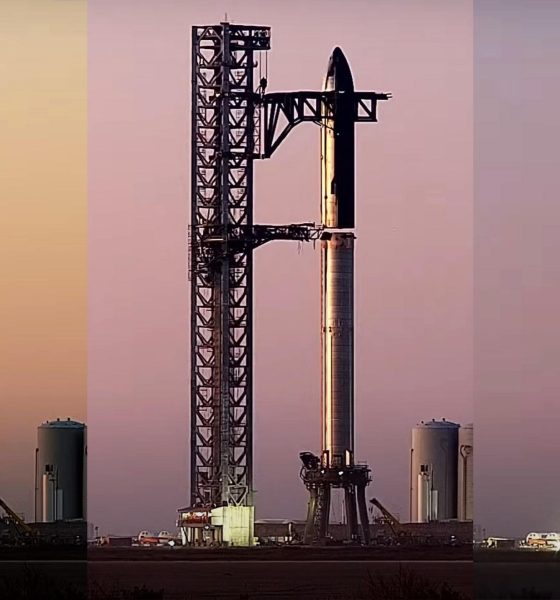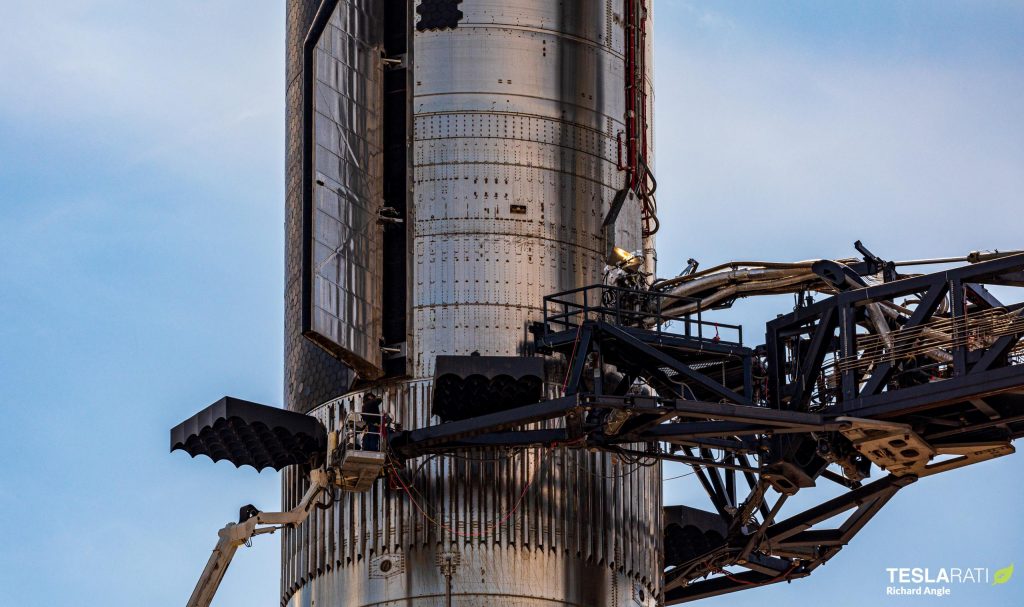

News
SpaceX rapidly stacks Starship and Super Heavy with ‘Mechazilla’
For the second time ever, SpaceX has used Starbase’s ‘Mechazilla’ tower and arms to stack a Starship upper stage on top of a Super Heavy booster.
This time around, though, SpaceX clearly learned a great deal from its second February 9th Starship stack and was able to complete the stacking process several times faster on March 15th. During the second attempt, depending on how one measures it, it took SpaceX around three and a half hours from the start of the lift to Starship fully resting on Super Heavy. With Stack #3, however, SpaceX was able to lift, translate, lower, and attach Starship to Super Heavy in just over an hour.
Oddly, SpaceX managed that feat without a claw-like device meant to grab and stabilize Super Heavy during stacking operations. For Stack #2, all three arms were fully in play. First, a pair of ‘chopsticks’ – giant arms meant to grab, lift, and even recover Starships and boosters – grabbed Ship 20, lifted it close to 100 meters (~300 ft) above the ground, rotated it over top of Super Heavy, and briefly paused. A third arm – known as the ship quick-disconnect or umbilical arm – swung in and extended its ‘claw’ to grab onto hardpoints located near the top of Super Heavy. Once the booster was secured, the ‘chopsticks’ slowly lowered Ship 20 onto Booster 4’s interstage and six clamps joined the two stages together.
A few hours after the two were clamped together, an umbilical device located on the swing arm extended and connected to Ship 20. It’s unclear if the panel was actually used in any way but the umbilical is designed to connect Starship to ground systems to supply propellant, power, communications, and other consumables. Regardless, the device did appear to connect to Starship. Prior to Stack #3, however, SpaceX removed both of the swing arm’s ‘claws,’ meaning that it had no way to grab onto Super Heavy. That diminished capability clearly appeared to have zero impact on the ease or speed of the stacking process given that it was completed a full three times faster than Stack #2.

That could imply that the claw is either completely unnecessary or only needed when attempting stacking operations in extreme winds. What is clear is that the claw removal likely only shaved a handful of minutes off of the full stacking process. What really saved time on Stack #3 was a faster lift and fewer pauses throughout – especially while lowering Starship the last several meters onto Super Heavy. During Stack #2, SpaceX took close to an hour and a half to fully lower Ship 20. The same sequence took just ~20 minutes during Stack #3.
Still, after the impressively rapid one-hour stack, it then took SpaceX close to two hours to connect the swing arm’s umbilical to Starship, leaving plenty of room for improvement. Ultimately, assuming SpaceX can speed up the start of the stacking process and replicate its Starship success with Super Heavy, which will also need to be grabbed and installed on an even more complex launch mount, it’s possible that Starbase’s orbital launch integration system is already capable of supporting multiple Starship launches per day. Of course, SpaceX has yet to demonstrate that the orbital launch site can be turned around in a matter of hours after being subjected to the violence and stresses of a Starship launch.
More significantly, SpaceX has never even attempted an orbital Starship launch, recovery, or reuse. That leaves the company in the unusual position of building and testing expensive, specialized support equipment before it actually knows that the rocket that equipment is designed to support is in any way capable of taking advantage of it. For an orbital spacecraft the size of Starship, only the Space Shuttle comes anywhere close and NASA’s all-time record for orbiter turnaround was 54 days. SpaceX has technically flown two Falcon 9 boosters twice in 27 days but no matter how impressive that feat is, reusing a far smaller suborbital booster is vastly easier than reusing a massive orbital spacecraft.
At the end of the day, it’s not really SpaceX’s fault that it’s still waiting for permission to attempt orbital test flights. Nonetheless, the growing gap in maturity between Starship and Super Heavy and the orbital launch site designed to support them continuously raises the risk that SpaceX will have to extensively redesign the rocket, its support equipment, or both if significant problems arise during orbital test flights.
Up next, there’s a chance that SpaceX could attempt to cryoproof Starship while on top of Super Heavy – or perhaps both stages at once. While SpaceX has performed more than half a dozen cryoproofs of Ship 20 and Booster 4 using the orbital launch site’s propellant storage and distribution system, it hasn’t fully tested the hardware needed to route hundreds of tons of propellant hundreds of feet into the air – essential for full-stack testing and launch operations.

Elon Musk
Elon Musk’s X will start using a Tesla-like software update strategy
The initiative seems designed to accelerate updates to the social media platform, while maintaining maximum transparency.

Elon Musk’s social media platform X will adopt a Tesla-esque approach to software updates for its algorithm.
The initiative seems designed to accelerate updates to the social media platform, while maintaining maximum transparency.
X’s updates to its updates
As per Musk in a post on X, the social media company will be making a new algorithm to determine what organic and advertising posts are recommended to users. These updates would then be repeated every four weeks.
“We will make the new 𝕏 algorithm, including all code used to determine what organic and advertising posts are recommended to users, open source in 7 days. This will be repeated every 4 weeks, with comprehensive developer notes, to help you understand what changed,” Musk wrote in his post.
The initiative somewhat mirrors Tesla’s over-the-air update model, where vehicle software is regularly refined and pushed to users with detailed release notes. This should allow users to better understand the details of X’s every update and foster a healthy feedback loop for the social media platform.
xAI and X
X, formerly Twitter, has been acquired by Elon Musk’s artificial intelligence startup, xAI last year. Since then, xAI has seen a rapid rise in valuation. Following the company’s the company’s upsized $20 billion Series E funding round, estimates now suggest that xAI is worth tens about $230 to $235 billion. That’s several times larger than Tesla when Elon Musk received his controversial 2018 CEO Performance Award.
As per xAI, the Series E funding round attracted a diverse group of investors, including Valor Equity Partners, Stepstone Group, Fidelity Management & Research Company, Qatar Investment Authority, MGX, and Baron Capital Group, among others. Strategic partners NVIDIA and Cisco Investments also continued support for building the world’s largest GPU clusters.
News
Tesla FSD Supervised wins MotorTrend’s Best Driver Assistance Award
The decision marks a notable reversal for the publication from prior years, with judges citing major real-world improvements that pushed Tesla’s latest FSD software ahead of every competing ADAS system.

Tesla’s Full Self-Driving (Supervised) system has been named the best driver-assistance technology on the market, earning top honors at the 2026 MotorTrend Best Tech Awards.
The decision marks a notable reversal for the publication from prior years, with judges citing major real-world improvements that pushed Tesla’s latest FSD software ahead of every competing ADAS system. And it wasn’t even close.
MotorTrend reverses course
MotorTrend awarded Tesla FSD (Supervised) its 2026 Best Tech Driver Assistance title after extensive testing of the latest v14 software. The publication acknowledged that it had previously criticized earlier versions of FSD for erratic behavior and near-miss incidents, ultimately favoring rivals such as GM’s Super Cruise in earlier evaluations.
According to MotorTrend, the newest iteration of FSD resolved many of those shortcomings. Testers said v14 showed far smoother behavior in complex urban scenarios, including unprotected left turns, traffic circles, emergency vehicles, and dense city streets. While the system still requires constant driver supervision, judges concluded that no other advanced driver-assistance system currently matches its breadth of capability.
Unlike rival systems that rely on combinations of cameras, radar, lidar, and mapped highways, Tesla’s FSD operates using a camera-only approach and is capable of driving on city streets, rural roads, and freeways. MotorTrend stated that pure utility, the ability to handle nearly all road types, ultimately separated FSD from competitors like Ford BlueCruise, GM Super Cruise, and BMW’s Highway Assistant.
High cost and high capability
MotorTrend also addressed FSD’s pricing, which remains significantly higher than rival systems. Tesla currently charges $8,000 for a one-time purchase or $99 per month for a subscription, compared with far lower upfront and subscription costs from other automakers. The publication noted that the premium is justified given FSD’s unmatched scope and continuous software evolution.
Safety remained a central focus of the evaluation. While testers reported collision-free operation over thousands of miles, they noted ongoing concerns around FSD’s configurable driving modes, including options that allow aggressive driving and speeds beyond posted limits. MotorTrend emphasized that, like all Level 2 systems, FSD still depends on a fully attentive human driver at all times.
Despite those caveats, the publication concluded that Tesla’s rapid software progress fundamentally reshaped the competitive landscape. For drivers seeking the most capable hands-on driver-assistance system available today, MotorTrend concluded Tesla FSD (Supervised) now stands alone at the top.
News
Elon Musk’s Grokipedia surges to 5.6M articles, almost 79% of English Wikipedia
The explosive growth marks a major milestone for the AI-powered online encyclopedia, which was launched by Elon Musk’s xAI just months ago.

Elon Musk’s Grokipedia has grown to an impressive 5,615,201 articles as of today, closing in on 79% of the English Wikipedia’s current total of 7,119,376 articles.
The explosive growth marks a major milestone for the AI-powered online encyclopedia, which was launched by Elon Musk’s xAI just months ago. Needless to say, it would only be a matter of time before Grokipedia exceeds English Wikipedia in sheer volume.
Grokipedia’s rapid growth
xAI’s vision for Grokipedia emphasizes neutrality, while Grok’s reasoning capabilities allow for fast drafting and fact-checking. When Elon Musk announced the initiative in late September 2025, he noted that Grokipedia would be an improvement to Wikipedia because it would be designed to avoid bias.
At the time, Musk noted that Grokipedia “is a necessary step towards the xAI goal of understanding the Universe.”
Grokipedia was launched in late October, and while xAI was careful to list it only as Version 0.1 at the time, the online encyclopedia immediately earned praise. Wikipedia co-founder Larry Sanger highlighted the project’s innovative approach, noting how it leverages AI to fill knowledge gaps and enable rapid updates. Netizens also observed how Grokipedia tends to present articles in a more objective manner compared to Wikipedia, which is edited by humans.
Elon Musk’s ambitious plans
With 5,615,201 total articles, Grokipedia has now grown to almost 79% of English Wikipedia’s article base. This is incredibly quick, though Grokipedia remains text-only for now. xAI, for its part, has now updated the online encyclopedia’s iteration to v0.2.
Elon Musk has shared bold ideas for Grokipedia, including sending a record of the entire knowledge base to space as part of xAI’s mission to preserve and expand human understanding. At some point, Musk stated that Grokipedia will be renamed to Encyclopedia Galactica, and it will be sent to the cosmos.
“When Grokipedia is good enough (long way to go), we will change the name to Encyclopedia Galactica. It will be an open source distillation of all knowledge, including audio, images and video. Join xAI to help build the sci-fi version of the Library of Alexandria!” Musk wrote, adding in a later post that “Copies will be etched in stone and sent to the Moon, Mars and beyond. This time, it will not be lost.”








